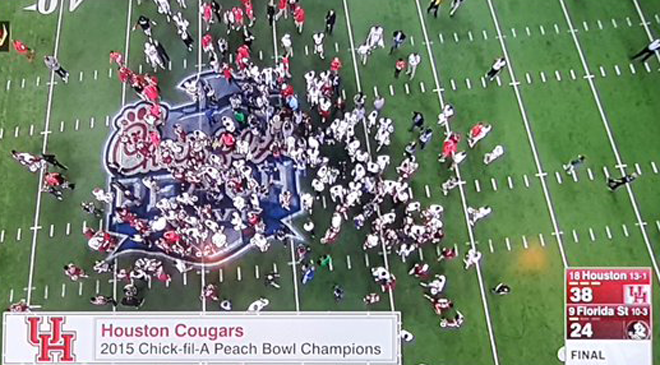Just a few years ago, former Clemson offensive coordinator Chad Morris was the nation’s only assistant making $1 million or more annually. Per USA Today, nine reached the seven-digit mark this season — and that only accounts for public universities, which have readily available financials.
In the Pac-12, Arizona State offensive coordinator Mike Norvell was the highest paid assistant at $950,000, a figure reached last offseason to keep the talented, young coach in Tempe. The arms race for assistants at the Power Five level spills into the head-coaching competition among the Group Five now, which must pony up unprecedented salaries to lure away prospective candidates like Norvell.
Memphis did just that earlier this month, wooing Norvell away from Todd Graham’s staff. Norvell’s contract specifics are not yet publicly available, though predecessor Justin Fuente earned half-a-million more last season than Norvell.
The transition at Memphis from Fuente to Norvell is the Group of Five Circle of Life played out perfectly: A talented coordinator from a more prominent program is giving his opportunity as a head coach, and is asked to rebuild; he does so in short order, earning praise and eventually, opportunities at programs with more resources.
Other American Athletic programs followed Memphis’ formula. The aforementioned Chad Morris left his well-compensated coordinator gig at Clemson to return to his home state of Texas and bring life back to the downtrodden SMU program.
Tulsa reached out to Baylor’s Philip Montgomery to reinvigorate the program in its move up to the American Athletic Conference from Conference USA.
Montgomery cultivated his explosive offensive during his time on Art Briles’ staff, and in his first season at Tulsa, that system led the Golden Hurricane to the nation’s No. 25 scoring average and a bowl bid.
Prolific passing offense defined Tulsa at a program high in the 1960s, behind the arm of quarterback Jerry Rhome, and again in the 2000s, when the Golden Hurricane gained Top 25 distinction with a staff that included the aforementioned Graham and Norvell.
“This program’s had success, no matter which conference it’s been in,” Montgomery said. “They had a couple down years…Because of the tradition and people have won, you knew you could get it back there. You got to do it the right way. You’ve got to go out and recruit, bring in players who are going to keep improving your skill level and size, and building on the positive things of the program.”
One positive Tulsa reached in Montgomery’s first season was that all-important bowl-game milestone.
The Golden Hurricane won their regular-season finale in a thrilling, come-from-behind defeat of Tulane to gain bowl eligibility after a two-year layoff, then went to the brink with Virginia Tech in the Independence Bowl, one of this postseason’s more exciting contests.
Tulsa’s fellow AAC program Houston’s enjoyed routine success over the years, particularly in the past decade. UH has managed to do so while sustaining the losses inherent with non-power conference success, maintaining from Briles to Kevin Sumlin and now Herman, with a slight dip during Tony Levine’s brief tenure.
Herman said Houston’s past gave him a foundation for building the program to its future.
Herman goes down the history of Houston football like a laundry list: “We’ve got a Heisman Trophy here [Andre Ware in 1989] who wore Cougar red. We’ve got multiple national award winners in Case Keenum, and Andre Ware, and David Klinger, and we’ve got 171 NFL draft picks, 12 first-round draft picks, multiple Pro Bowlers.
“The history and tradition here, starting all the way back with Coach [Bill] Yeoman, the fantastic teams he had all the way back in the Southwest Conference days, this is a program that’s certainly rich in tradition,” he added.
Invoking Yeoman’s tenure is certainly fitting. The Cougars were regularly contenders in a Southwest Conference that featured Arkansas, Texas and Texas A&M in the 1970s and 1980s, winning four league titles in Yeoman’s run.
Houston was on the top tier of college football then, and the 2015 season brought that aura back. A capacity crowd watched the Cougars’ AAC West-sealing win over Navy Thanksgiving weekend. Ditto their Top 25 showdown with Memphis.
That feeling of national prominence that once existed within Houston football is back. But for programs that have no such history — or at least, very little of it — program-builders have to invent a winning tradition.
USF only began playing football 18 years ago. The fledgling program had some success last decade under Jim Leavitt, now the defensive coordinator on MacIntyre’s Colorado staff. In 2007, the Bulls peaked at No. 2 in the national polls.
However, USF’s place among college football elite was nothing more than a flirtation. In the six years since Leavitt’s firing, the Bulls went on a steady decline that reached bottom with a 9-27 record from 2012 through 2014. In its brief history, USF had more evidence of being a loser than a winner, thus leaving current head coach Willie Taggart to appeal to players with concepts over history.
“You’ve got to have a vision, and you’ve got to have a plan,” Taggart said were the building blocks, adding the next cornerstone: “You’ve got to recruit…You’ve got to get some good players.”
That seems obvious enough, but how does one attract those players with only a vision to pitch? Fortunately for USF, it has two advantages: One is its location in the talent-rich recruiting hub of south Florida. The abundance of quality high school football in the Sunshine State gives USF a local appeal to high-level prospects.
Two is Taggart himself. Taggart had unique experience building a winner prior to his arrival at USF, taking over at Western Kentucky after an 0-12 finish in the Hilltoppers’ first FBS season.
When he came to USF pitching vision, it wasn’t just rhetoric. He had the tangible results to back up his talk.
“You’ve got to stick to what you believe in from Day 1. We haven’t wavered from anything that we set out to do,” Taggart said. Being steadfast and consistent as a coaching staff, even amid some rough times, as USF endured in Taggart’s first two seasons, starts to build a self-perpetuating process, as Taggart explained. This was what coaches refer to when discussing culture.
“By doing that, our guys understand, and they’re able to help the younger guys out. When we first got here, no one understood, so no one could help anyone else out. It’s going to take a little longer, but as the years go on and we recruit guys in here, the older guys understand what it takes [to win].”
Embedding such a culture isn’t easy with the increased and sped-up demands on programs now. Taggart said straying from the plan and seeking a quick fix can be a detriment to the rebuilding process, however.
“You’ve got to have the patience to see it through, and that’s what we’re seeing out of our guys,” he said. “Me personally, I don’t get emotionally hijacked.”
Avoiding outside criticism while focusing on the wins off the field — the victories that oftentimes go unnoticed by fans or media — is one way in which a rebuilding coach can stay on course in the early, trying years. Taggart said “taking care of…social and academic [progress] first and foremost” set the foundation for game-day wins in each of his last two stops.
By 2015, Taggart’s message began resonating on the scoreboard. The Bulls returned to the postseason for the first time since 2010 with an 8-4 regular-season record, and they were alive for the American’s East division championship on Thanksgiving weekend after dominating Top 25 opponent Temple earlier in the month.
Coincidentally, USF’s bounce-back season ended with a bowl-game loss to Western Kentucky, which continued building on the FBS foundation Taggart laid. Since reaching bowl eligibility in Taggart’s final two seasons in Bowling Green, the Hilltoppers won eight under Bobby Petrino in 2013; duplicated that mark in Jeff Brohm’s first season, 2014; and finished 2015 with 12 wins and the Conference USA championship.
Western Kentucky should find itself ranked in the final AP Top 25, a new milestone in the program-building project. But that’s only a milestone and not indicative of a job completed. Work’s never done, as USF’s regression from once holding the nation’s No. 2 billing to a two-game winner suggests.
There’s also more that can be won. For a program like Western Kentucky, that includes reaching a New Year’s Six bowl game, as Houston did this season under Herman. The Cougars dominated Florida State in the Chick-Fil-A Bowl, 38-24, scoring a program-defining win.
“They have truly reenergized not just a program, they haven’t just rejuvenated this program, but really reenergized an entire university and to a certain degree an entire city,” Herman said in his postgame press conference, via UHCougars.com.
American and Peach Bowl championships are not the limit for Herman’s project, either. The next phase is breaking the Group of Five barrier into the College Football Playoff, and pursuing the ultimate of milestones: a national championship. Of course, hitting that goal is a whole lot easier as a member of a Power Five conference, and Houston strengthened its case to do so with its epic 2015. Some, like UH’s chairman of the board of regents, hope to see the Cougars follow TCU’s arc under Gary Patterson and make the move to the Big 12.
Expectations change dramatically from there. What was once considered wildly successful becomes the norm, and more is demanded. As Leach said, a coach cannot put a ceiling on his program’s success. The building process is never done.




[…] Making The Program: Coaches Talk Building Winners in College Football […]